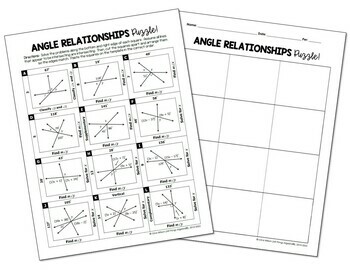
They are linear pairs of angles and supplementary angles. In geometry, there are two types of angles whose sum is 180 degrees. See the image attribution section for more information.Linear Pair of Angles Vs Supplementary Angles Openly licensed images remain under the terms of their respective licenses. This site includes public domain images or openly licensed images that are copyrighted by their respective owners.
#DESCRIBING SUPPLEMENTARY ANGLE RELATIONSHIPS LICENSE#
The Illustrative Mathematics name and logo are not subject to the Creative Commons license and may not be used without the prior and express written consent of Illustrative Mathematics. The second set of English assessments (marked as set "B") are copyright 2019 by Open Up Resources, and are licensed under the Creative Commons Attribution 4.0 International License (CC BY 4.0). Īdaptations and updates to IM 6–8 Math are copyright 2019 by Illustrative Mathematics, and are licensed under the Creative Commons Attribution 4.0 International License (CC BY 4.0).Īdaptations to add additional English language learner supports are copyright 2019 by Open Up Resources, and are licensed under the Creative Commons Attribution 4.0 International License (CC BY 4.0).Īdaptations and additions to create IM 6–8 Math Accelerated are copyright 2020 by Illustrative Mathematics, and are licensed under the Creative Commons Attribution 4.0 International License (CC BY 4.0).


OUR's 6–8 Math Curriculum is available at. It is licensed under the Creative Commons Attribution 4.0 International License (CC BY 4.0). IM 6–8 Math was originally developed by Open Up Resources and authored by Illustrative Mathematics®, and is copyright 2017-2019 by Open Up Resources. Privacy Policy | Accessibility Information They will also notice that the angles made by parallel lines cut by a transversal are the same and this observation is the key structure in this lesson. But how do the angle measures compare at the two vertices? It turns out that each angle at one vertex is congruent to the corresponding angle (via translation) at the other vertex and this can be seen using rigid motions: translations and \(180^\circ\) rotations are particularly effective at revealing the relationships between the angle measures.ĭuring the lesson, students will notice as they calculate angles that they are repeatedly using vertical and adjacent angles and that often they have a choice which method to apply (MP8). At each vertex, vertical and adjacent angles can be used to calculate all angle measures once one angle is known. There are now 8 angles, 4 each at the 2 intersection points of the lines. Next a third line is added, parallel to one of the two intersecting lines. The warm-up recalls previous facts about angles made by intersecting lines, including both vertical and adjacent angles.

In a previous lesson, \(180^\circ\) rotations were employed to show that vertical angles, made by intersecting lines, are congruent. This work continues here, with an emphasis on examining angles. Thus far in this unit, students have studied different types of rigid motions, using them to examine and build different figures. They practice finding an unknown angle given the measure of another angle that is complementary or supplementary. They are also introduced to the terms complementary, for describing two angles whose measures add to \(90^\circ\), and supplementary, for describing two angles whose measures add to \(180^\circ\). In this lesson, students justify that alternate interior angles are congruent, and use this and the vertical angle theorem, previously justified, to solve problems.


 0 kommentar(er)
0 kommentar(er)
